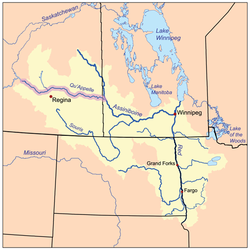| Wascana Creek | |
|---|---|
 Wascana Creek in Les Sherman Park, West End, downstream from the Albert Memorial Bridge and Wascana Lake | |
 The Red River drainage basin, with the Qu'Appelle River highlighted | |
| Physical characteristics | |
| Source | |
| • coordinates | 50°39′00″N104°55′02″W / 50.65000°N 104.91722°W [1] |
| Mouth | Qu'Appelle River |
| Basin features | |
| River system | Red River |
| Bridges | Albert Memorial Bridge and Sherwood Forest Bridge |
Wascana Creek is a river [2] in the Canadian province of Saskatchewan. It is a tributary of the Qu'Appelle River.
Contents
Originating in the fields east of Regina near Vibank, Wascana Creek travels south-east for approximately 45 kilometres (28 mi) before turning back west at Tyvan. The creek then travels in a north-westwardly direction following Highway 33 through Regina, where it was dammed by the Canadian Pacific Railway to create Wascana Lake. The lake was created to supply water for steam locomotives and to create a decorative image in Regina. [3] Below the lake, the creek leaves Regina and ends at the Qu'Appelle River about 1 mile west of Lumsden.
Sherwood Forest Bridge and Albert Memorial Bridge are two of the bridges that cross Wascana Creek. Near the mouth of the river in the Wascana Valley, is a provincial recreation site called Wascana Trails that were developed for use in the 2005 Canada Summer Games.
A 2011 study by Environment Canada found the creek to have high levels of pollution. [4]

